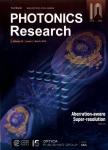Controlling multiphoton excited energy transfer from Tm^(3+) to Yb^(3+) ions by a phase-shaped femtosecond laser field
Controlling multiphoton excited energy transfer from Tm^(3+) to Yb^(3+) ions by a phase-shaped femtosecond laser field作者机构:State Key Laboratory of Precision Spectroscopy School of Physics and Materials Science East China Normal University State Key Laboratory of Silicon Materials Zhejiang University Collaborative Innovation Center of Extreme Optics Shanxi University
出 版 物:《Photonics Research》 (光子学研究(英文版))
年 卷 期:2019年第7卷第4期
页 面:486-492页
核心收录:
学科分类:0808[工学-电气工程] 0809[工学-电子科学与技术(可授工学、理学学位)] 07[理学] 0805[工学-材料科学与工程(可授工学、理学学位)] 0702[理学-物理学]
基 金:National Natural Science Foundation of China(NSFC)(11727810,11774094,61720106009,91850202) Shanghai Minhang Science and Technology Commission(16520721200,17ZR146900)
主 题:control the energy rare-earth ion-doped should have
摘 要:The ability to control the energy transfer in rare-earth ion-doped luminescent materials is very important for various related application areas such as color display, bio-labeling, and new light sources. Here, a phase-shaped femtosecond laser field is first proposed to control the transfer of multiphoton excited energy from Tm^(3+) to Yb^(3+) ions in co-doped glass ceramics. Tm^(3+) ions are first sensitized by femtosecond laser-induced multiphoton absorption, and then a highly efficient energy transfer occurs between the highly excited state Tm^(3+) sensitizers and the ground-state Yb^(3+) activators. The laser peak intensity and polarization dependences of the laser-induced luminescence intensities are shown to serve as proof of the multiphoton excited energy transfer *** efficiency of the multiphoton excited energy transfer can be efficiently enhanced or completely suppressed by optimizing the spectral phase of the femtosecond laser with a feedback control strategy based on a genetic algorithm. A(1+2) resonance-mediated three-photon excitation model is presented to explain the experimental observations. This study provides a new way to induce and control the energy transfer in rare-earth ion-doped luminescent materials, and should have a positive contribution to the development of related applications.



